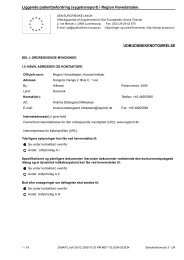Territorial Review Copenhagen - Region Hovedstaden
Territorial Review Copenhagen - Region Hovedstaden
Territorial Review Copenhagen - Region Hovedstaden
Create successful ePaper yourself
Turn your PDF publications into a flip-book with our unique Google optimized e-Paper software.
174<br />
in Denmark (Andersen, 2008). Municipalities must sell plots through open<br />
public procedures at the market price, which imposes significant restrictions<br />
on the municipality‘s possibility of catalysing the moderate cost housing<br />
market. Proposals have been created to reform this situation, though change<br />
has not occurred. 29 The national government may also wish to adjust its<br />
fairly centralised system of social housing to accommodate local needs, a<br />
topic that is discussed in more detail below.<br />
Social housing at a crossroads<br />
Co-operative housing in the <strong>Copenhagen</strong> metropolitan region faces<br />
multiple challenges. The magnitude of the rise in prices is surprisingly high:<br />
prices of co-operative dwellings have risen fivefold from 1999 to 2007 in the<br />
city of <strong>Copenhagen</strong>. 30 One key reason underlying the spike in price has been<br />
the integration of better-quality apartments, as many private and municipal<br />
rental properties have been converted into co-operative housing societies, as<br />
allowed by the Danish Rent Act. 31 Other factors include the below-market<br />
prices of housing co-operatives and the fact that capital gains are not taxed<br />
when co-operative housing dissolves. Consequently, there are instances<br />
where co-operatives ―dissolve themselves and sell the property, thereby<br />
reaping substantial capital gains‖ (OECD, 2005). A recent national level<br />
review of social housing in Denmark, Den almene boligsektors styring<br />
(2008), identified equally important challenges, including the provision of<br />
new stock at affordable prices and the refurbishment of antiquated buildings.<br />
The review also stressed the need to create the possibility for local<br />
adjustment, which is critical in <strong>Copenhagen</strong>, where many of the national<br />
issues are more acute.<br />
The City of <strong>Copenhagen</strong>‘s social housing has made progress in<br />
integrating immigrants into Danish society, though continued work lies<br />
ahead. The City of <strong>Copenhagen</strong> has often been challenged to provide social<br />
housing to immigrants in economically vibrant areas. Indeed, the City of<br />
<strong>Copenhagen</strong> has five neighbourhoods that the Minister of Social Affairs<br />
designated as vulnerable because a high proportion of their residents have<br />
little or no connection with the labour market. In an analysis of the first<br />
Danish dispersal policy, Damm and Rosholm (2005) found that refugees<br />
assigned to areas with lower immigrant concentration had a shorter<br />
transition period into the labour market than refugees assigned to immigrantdense<br />
cities. In a hearing during 2006, <strong>Copenhagen</strong>‘s City Council<br />
recognised the problematic integration policy and concentration of<br />
underprivileged groups in certain neighborhoods. Out of this meeting, the<br />
City of <strong>Copenhagen</strong> agreed to reduce the proportion of residents in<br />
vulnerable neighbourhoods with no connection to the labour market by 10<br />
percentage points by 2010. Housing need referrals to vulnerable areas and

















